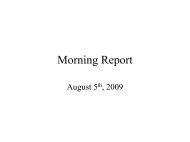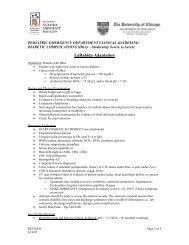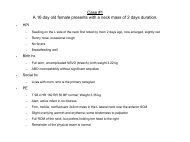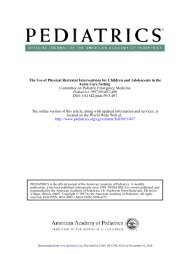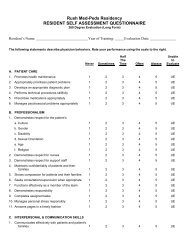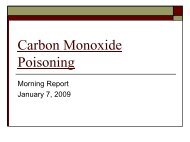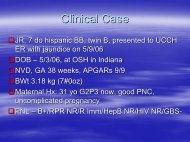the Rochester criteria - Department of Pediatrics
the Rochester criteria - Department of Pediatrics
the Rochester criteria - Department of Pediatrics
You also want an ePaper? Increase the reach of your titles
YUMPU automatically turns print PDFs into web optimized ePapers that Google loves.
Febrile Infants at Low Risk for Serious Bacterial Infection—An Appraisal <strong>of</strong> <strong>the</strong><br />
<strong>Rochester</strong> Criteria and Implications for Management<br />
Julie A. Jaskiewicz, Carol A. McCarthy, Amy C. Richardson, Kathleen C. White, Donna J.<br />
Fisher, Keith R. Powell, Ron Dagan and Febrile Infant Collaborative Study Groups<br />
<strong>Pediatrics</strong> 1994;94;390-396<br />
The online version <strong>of</strong> this article, along with updated information and services, is located on<br />
<strong>the</strong> World Wide Web at:<br />
http://www.pediatrics.org<br />
PEDIATRICS is <strong>the</strong> <strong>of</strong>ficial journal <strong>of</strong> <strong>the</strong> American Academy <strong>of</strong> <strong>Pediatrics</strong>. A monthly publication, it<br />
has been published continuously since 1948. PEDIATRICS is owned, published, and trademarked by <strong>the</strong><br />
American Academy <strong>of</strong> <strong>Pediatrics</strong>, 141 Northwest Point Boulevard, Elk Grove Village, Illinois, 60007.<br />
Copyright © 1994 by <strong>the</strong> American Academy <strong>of</strong> <strong>Pediatrics</strong>. All rights reserved. Print ISSN: 0031-4005.<br />
Online ISSN: 1098-4275.<br />
Downloaded from<br />
www.pediatrics.org.<br />
Provided by UNIV OF CHICAGO on November 10, 2010
Febrile Infants at Low Risk for Serious Bacterial Infection-An Appraisal<br />
<strong>of</strong> <strong>the</strong> <strong>Rochester</strong> Criteria and Implications for Management<br />
Julie A. Jaskiewicz, MD; Carol A. McCarthy, MD; Amy C. Richardson, MD; Kathleen C. White, BS;<br />
Donna J. Fisher, MD; Ron Dagan, MD*; Keith R. Powell, MD; and<br />
ABSTRACT. Objective. Prospective studies were conducted<br />
to test <strong>the</strong> hypo<strong>the</strong>sis that infants unlikely to have<br />
serious bacterial infections (SBI) can be accurately identified<br />
by low risk <strong>criteria</strong>.<br />
Methods. Febrile infants (rectal T 38#{176}C) 60 days<br />
<strong>of</strong> age were considered at low risk for SBI if <strong>the</strong>y met <strong>the</strong><br />
following <strong>criteria</strong>: 1) appear well; 2) were previously<br />
healthy; 3) have no focal infection; 4) have WBC count<br />
5.0-15.0 x 10 cells/L (5000-15 000/mm3), band form<br />
count 1.5 x 10 cells/L (1500/mm3), 10 WBC per high<br />
power field on microscopic examination <strong>of</strong> spun urine<br />
sediment, and 5 WBC per high power field on microscopic<br />
examination <strong>of</strong> a stool smear (if diarrhea). The<br />
recommended evaluation included <strong>the</strong> culture <strong>of</strong> specimens<br />
<strong>of</strong> blood, cerebrospinal fluid, and urine for bacteria<br />
Outcomes were determined. The negative predictive<br />
values <strong>of</strong> <strong>the</strong> low risk <strong>criteria</strong> for SBI and bacteremia<br />
were calculated.<br />
Results. Of 1057 eligible infants, 931 were well appearing,<br />
and, <strong>of</strong> <strong>the</strong>se, 437 met <strong>the</strong> remaining low risk<br />
<strong>criteria</strong>. Five low risk infants had SB! including two<br />
infants with bacteremia.<br />
The negative predictive value <strong>of</strong> <strong>the</strong> low risk <strong>criteria</strong><br />
was 98.9% (95% confidence interval, 97.2% to 99.6%) for<br />
SB!, and 99.5% (95% confidence interval, 98.2% to 99.9%)<br />
for bacteremia.<br />
Conclusions. These data confirm <strong>the</strong> ability <strong>of</strong> <strong>the</strong><br />
low risk <strong>criteria</strong> to identify infants unlikely to have SB!.<br />
Infants who meet <strong>the</strong> low risk <strong>criteria</strong> can be carefully<br />
observed without administering antimicrobial agents.<br />
<strong>Pediatrics</strong> 1994;94:390-.396; febrile infants, bacteremia,<br />
low risk <strong>criteria</strong>, serious bacterial infection.<br />
From <strong>the</strong> <strong>Department</strong> <strong>of</strong> <strong>Pediatrics</strong>, University <strong>of</strong> <strong>Rochester</strong> School <strong>of</strong> Medicine<br />
and Dentistry, <strong>Rochester</strong>, NY 14642, and <strong>the</strong> ‘Soroka Medical Center<br />
and Faculty for Health Sciences, Beer Sheva, Israel 84105.<br />
These data were presented in part before <strong>the</strong> Society for Pediatric Research<br />
in Washington, DC in May, 1989 (McCarthy et al) and <strong>the</strong> Ambulatory<br />
Pediatric Association in Baltimore, Maryland in May, 1992 (Jaskiewicz et al).<br />
Members <strong>of</strong> <strong>the</strong> Febrile Infant Collaborative Study Group: David N. Korones,<br />
MD, and Andrea Bracikowski, MD, University <strong>of</strong> <strong>Rochester</strong> School <strong>of</strong><br />
Medicine and Dentistry, <strong>Rochester</strong>, NY; Audra Deveikis, MD, and Harris<br />
Stutman, MD, Memorial Miller Children’s Hospital, Long Beach, CA; Jacob<br />
A. Lohr, MD, University <strong>of</strong> Virginia Children’s Medical Center, Charlottesvile,<br />
VA; Douglas W. Carlson, MD, and Robert M. Kennedy, MD, Washington<br />
University School <strong>of</strong> Medicine, St. Loins, MO; Patricia S. Beach, MD,<br />
University <strong>of</strong> Texas Medical Branch, Galveston, TX; Peter J. Krause, MD,<br />
and Thor Gudnason, MD, University <strong>of</strong> Connecticut, Hartford, CT; Marilyn<br />
Li, MD, Douglas Matsell, MD, and Ross Pennie, MD, University <strong>of</strong> Ottawa,<br />
Ottawa, Canada; Penelope H. Dennehy, MD, and Georges Peter, MD Brown<br />
University School <strong>of</strong> Medicine, Providence, RI.<br />
Received for publication Apr 26, 1993; accepted Feb 4, 1994.<br />
Reprint requests to (J.A.J.) Children’s Hospital Medical Center, Division <strong>of</strong><br />
General <strong>Pediatrics</strong>, 3333 Burnet Ave., Cincinnati, OH 45229-3039.<br />
PEDIATRICS (ISSN 0031 4005). Copyright © 1994 by <strong>the</strong> American Academy<br />
<strong>of</strong> <strong>Pediatrics</strong>.<br />
<strong>the</strong> Febrile Infant Collaborative Study Groups<br />
ABBREVIATIONS. SB!, seriousbacterial infection; CSF, cerebrospinal<br />
fluid; UT!, urinary tract infection.<br />
Strategies to identify infants less than 2 to 3<br />
months <strong>of</strong> age with serious bacterial infection (SBI)<br />
lack sufficient sensitivity to be clinically useful.’#{176}<br />
Therefore, <strong>the</strong> conservative management <strong>of</strong> febrile<br />
infants 60 days <strong>of</strong> age includes a complete evaluation<br />
for sepsis (blood, urine, and cerebrospinal fluid<br />
specimens for culture), hospitalization, and parenteral<br />
antimicrobial <strong>the</strong>rapy for a minimum <strong>of</strong> 48<br />
hours.11 Despite such recommendations, practice<br />
varies widely.’25 Our group has attempted to use<br />
low risk <strong>criteria</strong> to determine whe<strong>the</strong>r infants unlikely<br />
to have SBI can be identified with sufficient accuracy<br />
to consider less aggressive management for <strong>the</strong>se<br />
infants.<br />
The low risk <strong>criteria</strong> evolved from studies designed<br />
to test <strong>the</strong> hypo<strong>the</strong>sis that well appearing<br />
febrile infants who meet defined history, physical<br />
examination, and laboratory <strong>criteria</strong> are unlikely to<br />
have SBI.16’8 These low risk <strong>criteria</strong> are known as <strong>the</strong><br />
<strong>Rochester</strong> <strong>criteria</strong> for <strong>the</strong> evaluation <strong>of</strong> febrile infants<br />
(rectal T 38#{176}C)60 days <strong>of</strong> age (Table 1).<br />
The purpose <strong>of</strong> <strong>the</strong> present analysis was tw<strong>of</strong>old.<br />
First, we determined <strong>the</strong> ability <strong>of</strong> <strong>the</strong> <strong>Rochester</strong><br />
<strong>criteria</strong> to identify infants unlikely to have SBI and,<br />
particularly, bacteremia, based on <strong>the</strong> negative predictive<br />
value <strong>of</strong> <strong>the</strong> <strong>criteria</strong> when applied to a large<br />
number <strong>of</strong> prospectively evaluated febrile infants.<br />
Second, we used <strong>the</strong>se data to determine if refinements<br />
<strong>of</strong> <strong>the</strong> <strong>Rochester</strong> <strong>criteria</strong> should be studied<br />
fur<strong>the</strong>r.<br />
METHODS<br />
The present analysis includes data collected during three prospective<br />
studies (Table 2). For each study, only infants 60 days <strong>of</strong><br />
age who had a documented rectal temperature 38#{176}Cat home or<br />
at <strong>the</strong> time <strong>of</strong> medical evaluation were eligible for inclusion in <strong>the</strong><br />
study. Written informed consent was obtained for all infants enrolled<br />
in a study in which an intervention (eg, antimicrobial <strong>the</strong>rapy)<br />
was tested, and <strong>the</strong>se studies were approved by all appropnate<br />
human investigation committees.<br />
Patient Populations (Table 2)<br />
Study 1<br />
From July 1, 1987 to June 30, 1992 consecutive febrile infants<br />
seen in <strong>the</strong> Emergency <strong>Department</strong> or Pediatric Clinic at Strong<br />
Memorial Hospital in <strong>Rochester</strong>, NY were prospectively evaluated.<br />
Eighty-six infants participated in a previously published<br />
intervention study9 and are included in <strong>the</strong> present analysis.<br />
390 PEDIATRICS Downloaded Vol. 94from No. www.pediatrics.org<br />
3 September 1994.<br />
Provided by UNIV OF CHICAGO on November 10, 2010
TABLE 1. The <strong>Rochester</strong> Criteria<br />
1) Infant appears generally well<br />
2) Infant has been previously healthy<br />
. born at term (37 weeks gestation)<br />
. did not receive perinatal antimicrobial <strong>the</strong>rapy<br />
I was not treated for unexplained hyperbilirubinemia<br />
. had not received and was not receiving antimicrobial<br />
agents<br />
. had not been previously hospitalized<br />
. had no chronic or underlying illness<br />
. was not hospitalized longer than mo<strong>the</strong>r<br />
3) No evidence <strong>of</strong> skin, s<strong>of</strong>t tissue, bone, joint, or ear infection<br />
4) Laboratory values:<br />
. peripheral blood WBC count 5.0 to 15.0 X 10 cells/L<br />
(5000 to 15 000/mm3)<br />
. absolute band form count 1.5 X 1O cells/L (1500/<br />
mm3)<br />
. :s10 WBC per high power field (x40) on microscopic<br />
examination <strong>of</strong> a spun urine sediment<br />
. 5 WBC per high power field (X40) on microscopic<br />
examination <strong>of</strong> a stool smear (only for infants with<br />
diarrhea)<br />
Seventeen <strong>of</strong> <strong>the</strong>se infants were enrolled at <strong>Rochester</strong> General<br />
Hospital.19<br />
Study 2<br />
From July 1, 1984 to November 30, 1984, consecutive febrile<br />
infants evaluated for suspected sepsis and hospitalized at Strong<br />
Memorial Hospital in <strong>Rochester</strong>, NY were prospectively evaluated.<br />
Study 3<br />
During 1985 through 1988 participants in <strong>the</strong> Febrile Infant<br />
Collaborative Study Group prospectively identified febrile infants<br />
at low risk for SBI by <strong>the</strong> <strong>Rochester</strong> <strong>criteria</strong>. In a multicenter<br />
interventional study, <strong>the</strong>se infants were randomly assigned to<br />
hospitalization for observation only or hospitalization and parenteral<br />
antimicrobial <strong>the</strong>rapy.<br />
Data Collection<br />
Data obtained on all infants included: age, sex, race, global<br />
assessment (judged to be well or ill appearing, by house <strong>of</strong>ficer or<br />
attending physician assessment without reference to specific ciitena<br />
and without reliability testing), past medical history, physical<br />
examination, and laboratory evaluation as detailed in Table 1.<br />
Examination <strong>of</strong> a stool smear in infants with diarrhea was not<br />
done in Study 2 (Table 2). Specimens <strong>of</strong> blood, CSF, and urine<br />
(obtained by bladder tap or ca<strong>the</strong>terization) for culture for bacterial<br />
pathogens were obtained. Urine specimens from selected low<br />
risk infants observed without antimicrobial <strong>the</strong>rapy during 1989<br />
through 1992 were not cultured because <strong>of</strong> physician preference.<br />
Additional specimens for culture were obtained at <strong>the</strong> discretion<br />
<strong>of</strong> <strong>the</strong> examining physician. Chest roentgenograms were performed<br />
when clinically indicated (tachypnea, cough, focal abnormality<br />
on physical examination <strong>of</strong> lungs). Urinalyses and stool<br />
smear examinations were performed by examining physicians.<br />
Skin, s<strong>of</strong>t tissue, and ear infections were diagnosed by physical<br />
examination.<br />
Specimens for culture were evaluated using standard techniques<br />
in <strong>the</strong> diagnostic microbiology laboratories <strong>of</strong> <strong>the</strong> participaling<br />
centers. Commensal bacteria isolated from blood or CSF<br />
specimens were considered contaminants (eg, Staphiococcus epidermidis,<br />
ci- or y-hemolytic streptococci (excluding enterococcus,<br />
Streptococcus pneumoniae, and group D streptococci), dip<strong>the</strong>roid<br />
sp., bacillus sp.). Serious bacterial infections were defined as bacteremia,<br />
meningitis, osteomyelitis, suppurative arthritis, s<strong>of</strong>t hasue<br />
infections (cellulitis, abscess, mastitis, omphalitis), urinary<br />
tract infection, gastroenteritis, and pneumonia. S<strong>of</strong>t tissue infections<br />
were defined by physical examination with or without isolation<br />
<strong>of</strong> a bacterial pathogen. UT! was defined as <strong>the</strong> isolation <strong>of</strong><br />
>10 colony forming units per milliliter <strong>of</strong> urine <strong>of</strong> a single pathogen.<br />
Urine specimens with more than one isolate were considered<br />
to be contaminated. Bacterial pneumonia was defined as a focal<br />
infiltrate on chest roentgenogram in association with a bacterial<br />
pathogen isolated from <strong>the</strong> blood or <strong>the</strong> presence <strong>of</strong> capsular<br />
polysaccharide in <strong>the</strong> urine detected by counterimmunoelectrophoresis.<br />
All evaluations were performed and data recorded by <strong>the</strong><br />
house <strong>of</strong>ficer and/or supervising attending physician in <strong>the</strong> emergency<br />
department or pediatric clinic where <strong>the</strong> infant was seen.<br />
An investigator verified age, temperature, and completeness <strong>of</strong><br />
data collection for each infant by chart review. All infants in each<br />
study for whom complete data were available were classified as<br />
low risk or not low risk by <strong>the</strong> <strong>Rochester</strong> <strong>criteria</strong> in Table 1<br />
(excluding stool smear examination for infants in Study 2, Table<br />
2). Since well appearing infants who do not meet at least one <strong>of</strong> <strong>the</strong><br />
low risk <strong>criteria</strong> are excluded from <strong>the</strong> low risk group, such infants<br />
were included in <strong>the</strong> analysis in <strong>the</strong> not low risk group even when<br />
all classifying data were not available. Treatment decisions were<br />
made on an individual basis by <strong>the</strong> evaluating physician, except<br />
when <strong>the</strong> infant was enrolled in a protocol mandating treatment<br />
versus no treatment (Study and Study 3 (Table 2)).<br />
Statistical Methods<br />
Chi square analysis was used for comparisons <strong>of</strong> sex, age, and<br />
race between low risk and not low risk infants and for comparisons<br />
<strong>of</strong> <strong>the</strong> proportion <strong>of</strong> SB! in low risk and not low risk groups<br />
between studies. The difference in <strong>the</strong> proportion <strong>of</strong> SB! among<br />
low risk infants in each <strong>of</strong> <strong>the</strong> three studies (Table 2) was not<br />
statistically significant, <strong>the</strong>refore data from low risk infants in each<br />
study were combined. Since only low risk infants were included in<br />
Study 3, <strong>the</strong>se data were not used to calculate <strong>the</strong> negative predictive<br />
value <strong>of</strong> <strong>the</strong> low risk <strong>criteria</strong>. The differences in <strong>the</strong> proportion<br />
<strong>of</strong> SB! among low risk infants and among not low risk<br />
infants between Studies I and 2 were not statistically significant.<br />
Therefore, data from Studies I and 2 were combined for complete<br />
analysis and calculation <strong>of</strong> <strong>the</strong> negative predictive value <strong>of</strong> <strong>the</strong><br />
<strong>criteria</strong>.<br />
The operating characteristics <strong>of</strong> <strong>the</strong> low risk <strong>criteria</strong> and <strong>the</strong><br />
<strong>criteria</strong> components were calculated by <strong>the</strong> following: sensitivity,<br />
<strong>the</strong> rate <strong>of</strong> a positive test in infants with disease; specificity, <strong>the</strong><br />
rate <strong>of</strong> a negative test in infants without disease; and negative<br />
predictive value, <strong>the</strong> rate <strong>of</strong> no disease in infants who test negafive.<br />
The 95% confidence intervals <strong>of</strong> each test’s operating characteristics<br />
were calculated using <strong>the</strong> method <strong>of</strong> Reiss.#{176}<br />
RESULTS<br />
From 1984 to 1992, 1057 febrile infants 60 days <strong>of</strong><br />
age were identified as eligible for analysis (Studies I<br />
and 2 (Table 2) and Fig 1). Infants with insufficient<br />
data to determine risk (N = 54) and ifi appearing<br />
infants (N = 72) were excluded from fur<strong>the</strong>r analysis.<br />
Of 931 evaluable, well appearing infants, 437 met<br />
all low risk <strong>criteria</strong> and 494 did not (Fig 1). An<br />
additional 74 low risk infants (Study 3 (Table 2))<br />
identified by <strong>the</strong> <strong>Rochester</strong> <strong>criteria</strong> were induded in<br />
discussion <strong>of</strong> <strong>the</strong> low risk group only, bringing <strong>the</strong><br />
total number <strong>of</strong> low risk infants to 511 (Fig 1).<br />
Table 3 shows <strong>the</strong> distribution <strong>of</strong> <strong>the</strong> low risk and<br />
not low risk infants by age. There were no differences<br />
in sex, race, or age between low risk and not<br />
low risk infants. SBI was documented in 66 (7.1%) <strong>of</strong><br />
931 study infants and bacteremia in 13 (1.4%). The<br />
distribution <strong>of</strong> SBI and bacteremia by age and risk<br />
group is shown in Fig 2.<br />
Specimens cultured for bacterial pathogens and<br />
isolation rates from <strong>the</strong> study infants are shown in<br />
Table 4. Sixty-six infants had SBI. No bacterial pathogens<br />
were isolated from seven infants with skin or<br />
s<strong>of</strong>t tissue infections and from one infant with pneumonia.<br />
The same pathogen was isolated from blood<br />
and urine in three infants and from urine and s<strong>of</strong>t<br />
tissue in one infant.<br />
Downloaded from<br />
www.pediatrics.org.<br />
Provided by UNIV OF CHICAGO on November 10, 2010 ARTICLES 391
TABLE 2. Studies Included in Present Analysis<br />
I McCarthy CA and Jaskiewicz JA, et al<br />
2 Dagan R<br />
Study Years Total Low Risk<br />
(SB!/Bacteremia)<br />
Insufficient data<br />
N=54<br />
II appearing<br />
N=72<br />
392 FEBRILE INFANTS AT LOW RISK FOR SB!<br />
1987 through 1992<br />
1984<br />
978<br />
79<br />
381 (5/2)<br />
56 (0/0)<br />
Not Low<br />
Risk<br />
472<br />
22<br />
Ill Appearing,*<br />
Insufficient Data<br />
Total 1 1057 437 (5/2) 494 126<br />
3 Febrile Infant Collaborative Study Group 1985 through 1988 74 74(0/0)<br />
Total 2 511 (5/2)<br />
* Not induded in analysis.<br />
:: Reference 19.<br />
Fig 1. Algorithm to identify low risk febrile infants. *Difference<br />
from low risk group: P < .05. **Febnie Infant Collaborative Study<br />
Group.<br />
Low Risk Infants<br />
SBI occurred in five (1.0%) <strong>of</strong> 511 low risk infants.<br />
Three infants, age 25, 41, and 54 days, had UTI<br />
caused by Group B streptococcus, E. coli, and E. coli,<br />
respectively. None <strong>of</strong> <strong>the</strong> three infants were initially<br />
treated with antimicrobial agents, but all were<br />
treated as soon as cultures became positive and all<br />
did well. One 34-day-old infant was hospitalized for<br />
observation and did not receive empiric antimicrobial<br />
<strong>the</strong>rapy. When Yersinia enterocolitica was isolated<br />
from a blood specimen on <strong>the</strong> second hospital day,<br />
antimicrobial <strong>the</strong>rapy was begun and <strong>the</strong> infant did<br />
well. A repeat blood specimen for culture was not<br />
obtained before antimicrobial <strong>the</strong>rapy was begun.<br />
TABLE 3. Age Distribution y Risk Group<br />
Age (days) Total<br />
(n = 1005)<br />
0 to 14<br />
15 to 30<br />
31 to 45<br />
46 to 60<br />
Low Risk<br />
(n = 511)*<br />
125<br />
1<br />
Not Low Risk<br />
(n = 494)<br />
n (%) n (%) n (%)<br />
142 (14.1)<br />
294 (29.2)<br />
303 (30.2)<br />
266 (26.5)<br />
73 (14.3)<br />
154 (30.1)<br />
157 (30.7)<br />
127 (24.9)<br />
* Includes 74 low risk infants from Study 3 (Table 2).<br />
69 (13.9)<br />
140 (28.2)<br />
146 (29.7)<br />
139 (28.2)<br />
One 29-day-old infant, enrolled in a study <strong>of</strong> outpatient<br />
management <strong>of</strong> selected low risk infants,19 was<br />
treated with intramuscular ceftriaxone at <strong>the</strong> time <strong>of</strong><br />
evaluation. At <strong>the</strong> 24-hour follow-up, <strong>the</strong> infant was<br />
afebrile and appeared well, but <strong>the</strong> blood culture was<br />
positive for Neisseria meningitidis. The infant was hospitalized<br />
and received a total <strong>of</strong> 7 days <strong>of</strong> once daily<br />
intramuscular ceftriaxone and did well. At <strong>the</strong> time<br />
<strong>of</strong> hospitalization two doses <strong>of</strong> ceftriaxone had already<br />
been given, <strong>the</strong>refore a repeat blood culture<br />
was not obtained.<br />
Of 51 1 low risk infants, 308 (60.3%) were initially<br />
treated with antimicrobial agents and 203 (39.7%)<br />
were not. Eighty-six low risk infants were enrolled in<br />
a study <strong>of</strong> outpatient management <strong>of</strong> febrile infants<br />
and all received intramuscular ceftriaxone (Study I<br />
(Table 2)). Seventy-four low risk infants were randomized<br />
to receive ei<strong>the</strong>r parenteral antimicrobial<br />
agents following hospitalization (N = 41) or hospitaization<br />
and observation alone (N = 33) (Study 3<br />
(Table 2)). The remaining low risk infants were given<br />
antimicrobial <strong>the</strong>rapy at <strong>the</strong> discretion <strong>of</strong> <strong>the</strong> evaluating<br />
physician.<br />
Negative Predictive Value <strong>of</strong> <strong>the</strong> <strong>Rochester</strong> Criteria<br />
Five <strong>of</strong> 437 low risk infants in Studies I and 2<br />
(Table 2) had SBI and two had bacteremia. The statistical<br />
analysis did not include <strong>the</strong> 74 infants from<br />
Study 3 (Table 2). Based on <strong>the</strong>se data, <strong>the</strong> negative<br />
predictive value <strong>of</strong> <strong>the</strong> <strong>Rochester</strong> <strong>criteria</strong> is 98.9%<br />
with a 95% confidence interval <strong>of</strong> 97.2% to 99.6% for<br />
any SBI, and 99.5% with a 95% confidence interval <strong>of</strong><br />
98.2% to 99.9% for bacteremia.<br />
Not Low Risk Infants<br />
SBI occurred in 61 (12.3%) <strong>of</strong> 494 infants who did<br />
not meet <strong>the</strong> low risk <strong>criteria</strong>, including UTI (31<br />
infants), skin or s<strong>of</strong>t tissue infection (18), bacteremia<br />
(11), gastroenteritis (4), and pneumonia (1, lobar infiltrate<br />
and urine positive for S. pneumoniae antigen<br />
Downloaded from<br />
www.pediatrics.org.<br />
Provided by UNIV OF CHICAGO on November 10, 2010
N<br />
U<br />
m<br />
b<br />
e<br />
0<br />
P<br />
a<br />
e<br />
S<br />
Age (days)<br />
- SBI<br />
- Bacteremia<br />
Fig 2. Distribution <strong>of</strong> SB! and bacteremia in 1005* febrile infants.<br />
LR, low risk; NLR, not low risk *includes 74 low risk infants from<br />
study 3, Table 2.<br />
by counterimmunoelectrophoresis). Three infants<br />
with UTI also had bacteremia, and one infant with<br />
UTI had mastitis. (Complete data are available from<br />
K.R.P. upon request.)<br />
Evaluation <strong>of</strong> <strong>the</strong> Components <strong>of</strong> <strong>the</strong> <strong>Rochester</strong> Criteria<br />
Global Assessment<br />
Infants who were not well appearing were managed<br />
expectantly and not included for data analysis.<br />
Of 72 ill appearing infants who had outcomes ascertamed,<br />
<strong>the</strong> 16 SBIs included eight UTI, three meningitis,<br />
two bacteremia, two mastitis, and one gastroenteritis.<br />
Medical History<br />
Of <strong>the</strong> 494 infants excluded from <strong>the</strong> low risk<br />
group, 181 (36.6%) were not previously healthy by<br />
history. Fourteen (7.7%) <strong>of</strong> <strong>the</strong>se infants had SBI,<br />
including five (2.8%) infants with bacteremia. A history<br />
<strong>of</strong> not being previously healthy was <strong>the</strong> only<br />
reason for excluding 92 infants from <strong>the</strong> low risk<br />
group. One infant with only a history <strong>of</strong> photo<strong>the</strong>rapy<br />
for unexplained hyperbilirubinemia had Group<br />
B streptococcus bacteremia. One infant with a history<br />
<strong>of</strong> both prior hospitalization and prior antimicrobial<br />
<strong>the</strong>rapy had E. coli UTI. Twenty-one infants excluded<br />
from <strong>the</strong> low risk group by history did not have<br />
urinalyses performed. Of <strong>the</strong>se infants, one who had<br />
only a history <strong>of</strong> prematurity had Salmonella bacteremia.<br />
Only two infants had a history <strong>of</strong> chronic illness<br />
and nei<strong>the</strong>r had SB!. No infant excluded solely because<br />
<strong>of</strong> perinatal antimicrobial <strong>the</strong>rapy (N = 7),<br />
hospitalization longer than <strong>the</strong> mo<strong>the</strong>r (N = I), or<br />
both (N = 16) had SB!.<br />
Physical Examination<br />
Skin, s<strong>of</strong>t tissue, or ear infection was observed in<br />
97 (20.0%) <strong>of</strong> <strong>the</strong> 494 infants excluded from <strong>the</strong> low<br />
risk group. Seventy-nine infants had otitis media,<br />
and in 36 otitis media was <strong>the</strong> only reason for exclusion<br />
from <strong>the</strong> low risk group. None <strong>of</strong> <strong>the</strong> 79 infants<br />
with otitis media had bacteremia or meningitis. Four<br />
infants with otitis media had E. coli UT!. One <strong>of</strong> <strong>the</strong>se<br />
TABLE 4. Isolation Rates <strong>of</strong> Bacterial Pathogens in 931 Study<br />
Infants<br />
Specimen Patients Bacterial Bacterial<br />
Pathogen Contaminant<br />
Isolated Isolated<br />
* CSF, cerebrospinal fluid.<br />
n (%) n (%) n (%)<br />
Blood 922 (99.0) 13 (1.4) 48 (5.2)<br />
CSF’ 902 (97.0) 0 (0.0) 47 (5.2)<br />
Urine 694 (74.5) 34 (4.9) 108 (15.6)<br />
Stool 63 (6.8) 4 (6.3) 0 (0.0)<br />
O<strong>the</strong>r 131 (14.1) 11 (8.4) 0 (0.0)<br />
infants was also excluded from <strong>the</strong> low risk group by<br />
history, and three had abnormal laboratory assessments.<br />
Eighteen infants had skin or s<strong>of</strong>t tissue infection,<br />
including cellulitis (9), omphalitis (3), mastitis (2),<br />
abscess (3), and paronychia (1). Specimens from<br />
<strong>the</strong>se sites were obtained from I 1 infants and all<br />
yielded pathogens. Isolates included Staphylococcus<br />
aureus (6), E. coli (3), Group B streptococcus (1), and<br />
Neisseria sp. (I). Seven infants with skin or s<strong>of</strong>t tissue<br />
infection were excluded from <strong>the</strong> low risk group on<br />
that basis alone. No infant with skin or s<strong>of</strong>t tissue<br />
infection had bacteremia or meningitis. No study<br />
infant had a bone or joint infection.<br />
Laboratory Assessment<br />
Of <strong>the</strong> 494 infants excluded from <strong>the</strong> low risk<br />
group, 325 (65.8%) had at least one abnormal laboratory<br />
test. One or more abnormal laboratory test<br />
was <strong>the</strong> only reason for excluding 226 infants from<br />
<strong>the</strong> low risk group. Specificity, sensitivity, and negative<br />
predictive value for each test was calculated.<br />
No individual test or combination <strong>of</strong> tests had a<br />
sensitivity <strong>of</strong> 75%. The band form count was<br />
:I .5 X 1O cells/L (15OO/mm3), and <strong>the</strong> urine<br />
WBC count was 1O for most infants without SB!,<br />
having specificities <strong>of</strong> 96% and 98%, respectively.<br />
Urinalysis<br />
Urinalyses were obtained from 907 (90.2%) <strong>of</strong> 1005<br />
infants. Urine specimens from 42 (4.6%) <strong>of</strong> 909 infants<br />
had >10 white blood cells per high power field<br />
on microscopic examination <strong>of</strong> spun sediment.<br />
Twenty infants with >10 WBC on urinalysis had UT!<br />
(17 E. coli, I Group B streptococcus, and 2 Enter-<br />
obacter cloacae), 2 had E. coli UT! and bacteremia, and<br />
I had S. aureus bacteremia. Results <strong>of</strong> urinalyses were<br />
recorded in 32 <strong>of</strong> 34 infants with UT!. Of <strong>the</strong>se, 11<br />
specimens had I0 WBC per high power field. Eight<br />
<strong>of</strong> <strong>the</strong>se infants were excluded from <strong>the</strong> low risk<br />
group by o<strong>the</strong>r <strong>criteria</strong>, and three met all low risk<br />
<strong>criteria</strong>.<br />
Urinalyses were not recorded for 98 infants excluded<br />
from <strong>the</strong> low risk group by one or more <strong>of</strong> <strong>the</strong><br />
o<strong>the</strong>r <strong>criteria</strong>. Eleven <strong>of</strong> <strong>the</strong>se infants had SB!; three<br />
<strong>of</strong> <strong>the</strong>m were bacteremic.<br />
Stool Smear<br />
Four infants with diarrhea had >5 WBC per high<br />
power field on microscopic examination <strong>of</strong> a stool<br />
Downloaded from<br />
www.pediatrics.org.<br />
Provided by UNIV OF CHICAGO on November 10, 2010<br />
ARTICLES 393
smear. Cultures <strong>of</strong> stool specimens from two <strong>of</strong> <strong>the</strong>se<br />
infants revealed no pathogens, no stool specimen<br />
was sent for culture from <strong>the</strong> third infant, and both<br />
Salmonella sp. and Yersinia enterocolitica were isolated<br />
from a stool specimen from <strong>the</strong> fourth infant. Salmonella<br />
enteritidis was isolated from stool specimens<br />
from three additional infants. Stool smear results<br />
were not recorded for two infants, and one had a<br />
normal stool smear. All four infants with bacterial<br />
gastroenteritis had ei<strong>the</strong>r an abnormal peripheral<br />
blood WBC count, band form count, or both.<br />
DISCUSSION<br />
A recent meta-analysis <strong>of</strong> studies <strong>of</strong> febrile infants<br />
60 days <strong>of</strong> age showed that infants meeting <strong>the</strong><br />
<strong>Rochester</strong> <strong>criteria</strong> had a lower probability <strong>of</strong> having<br />
SBI than if o<strong>the</strong>r strategies were employed.21 The<br />
present study prospectively evaluated a large number<br />
<strong>of</strong> febrile infants to fur<strong>the</strong>r test <strong>the</strong> ability <strong>of</strong> <strong>the</strong><br />
<strong>Rochester</strong> <strong>criteria</strong> to accurately identify infants unlikely<br />
to have SB!. The negative predictive value <strong>of</strong><br />
<strong>the</strong> <strong>Rochester</strong> <strong>criteria</strong> was chosen as <strong>the</strong> most appropriate<br />
test to identify infants unlikely to have SB!. The<br />
95% confidence interval for <strong>the</strong> negative predictive<br />
value <strong>of</strong> <strong>the</strong> <strong>Rochester</strong> <strong>criteria</strong> for SB! (97.2% to<br />
99.6%) and for bacteremia (98.2% to 99.9%) confirm<br />
<strong>the</strong> ability <strong>of</strong> <strong>the</strong> <strong>Rochester</strong> <strong>criteria</strong> to identify febrile<br />
infants unlikely to have SB!.<br />
Because <strong>the</strong> <strong>Rochester</strong> <strong>criteria</strong> were designed to<br />
identify infants unlikely to have SB!, only well appearing<br />
infants were included in <strong>the</strong> present study.<br />
By excluding ill appearing infants from <strong>the</strong> study<br />
population, <strong>the</strong> prevalence <strong>of</strong> SB! in our study is<br />
lower than that observed in previous studies (7% vs<br />
9%)9 While <strong>the</strong> negative predictive value <strong>of</strong> <strong>the</strong><br />
<strong>Rochester</strong> <strong>criteria</strong> may be lower when <strong>the</strong> <strong>criteria</strong> are<br />
applied to a population including ill appearing infants<br />
(higher prevalence <strong>of</strong> SB! in this group), it is<br />
most appropriate to apply <strong>the</strong> <strong>Rochester</strong> <strong>criteria</strong> only<br />
to well appearing febrile infants. Although not stated<br />
as a criterion in early studies,16”8 ill appearing infants<br />
have always been excluded when evaluating <strong>the</strong> low<br />
risk <strong>criteria</strong>. Most investigators agree that ill appearing<br />
infants have a higher likelihood <strong>of</strong> SB! than well<br />
appearing infants,13’4’6’7 and <strong>the</strong>re is little controversy<br />
regarding <strong>the</strong>ir management. The consensus is that<br />
such infants should be hospitalized and treated with<br />
antimicrobial <strong>the</strong>rapy regardless <strong>of</strong> <strong>the</strong> remainder <strong>of</strong><br />
<strong>the</strong>ir evaluation.<br />
The present study shows that among well appearing<br />
infants <strong>the</strong> <strong>Rochester</strong> <strong>criteria</strong> work well. We believe<br />
<strong>the</strong> narrow confidence interval around <strong>the</strong> negative<br />
predictive value <strong>of</strong> <strong>the</strong> <strong>Rochester</strong> <strong>criteria</strong><br />
supports <strong>the</strong> clinical use <strong>of</strong> <strong>the</strong>se <strong>criteria</strong>.<br />
Management <strong>of</strong> Infants Who Meet <strong>the</strong><br />
<strong>Rochester</strong> Criteria<br />
Our data strongly suggest that infants who meet<br />
<strong>the</strong> <strong>Rochester</strong> <strong>criteria</strong> can be carefully observed without<br />
parenteral antimicrobial agents. Over one-third<br />
<strong>of</strong> <strong>the</strong> low risk infants in <strong>the</strong> present study were not<br />
initially treated with antimicrobial <strong>the</strong>rapy, and all<br />
did well. Four <strong>of</strong> five low risk infants with SB! did<br />
not receive antimicrobial <strong>the</strong>rapy until cultures be-<br />
394 FEBRILE INFANTS AT LOW RISK FOR SBI<br />
came positive. With careful observation and followup,<br />
appropriate <strong>the</strong>rapy was initiated when SB! was<br />
diagnosed and no infant experienced untoward effects.<br />
One low risk infant with N. meningitidis bacteremia<br />
initially received antimicrobial <strong>the</strong>rapy, and<br />
<strong>the</strong> outcome <strong>of</strong> this particular infant without antimicrobial<br />
<strong>the</strong>rapy remains unknown. It has been<br />
shown, however, that in some cases bacteremia with<br />
this organism has resolved without antimicrobial<br />
<strong>the</strong>rapy. O<strong>the</strong>r investigations support observation<br />
for low risk infants. In a study by Wasserman et aP5<br />
five infants less than 3 months <strong>of</strong> age were hospitalized<br />
and observed without antimicrobial <strong>the</strong>rapy un-<br />
61 cultures <strong>of</strong> blood (I), urine (3), and stool (1) were<br />
reported positive for bacterial pathogens. Outcomes<br />
“did not appear to be altered by <strong>the</strong> delay in diagnosis<br />
and treatment”.’5 A recent study by Baker et<br />
aP also demonstrated that selected febrile infants 29<br />
to 56 days <strong>of</strong> age may be managed without antimicrobial<br />
<strong>the</strong>rapy.<br />
An alternative strategy for <strong>the</strong> management <strong>of</strong> <strong>the</strong><br />
low risk febrile infant is to administer a single dose <strong>of</strong><br />
intramuscular ceftriaxone following a complete laboratory<br />
evaluation for suspected sepsis (cultures <strong>of</strong><br />
specimens <strong>of</strong> blood, CSF, and urine (obtained by<br />
bladder tap or ca<strong>the</strong>terization)) and to provide as<br />
careful outpatient follow-up as possible. This approach<br />
was studied in infants 60 days <strong>of</strong> age by<br />
McCarthy et aP9 with no bad outcomes. Baskin et a124<br />
also managed selected febrile infants between 28 and<br />
89 days <strong>of</strong> age as outpatients following a single dose<br />
<strong>of</strong> intramuscular ceftriaxone. All <strong>of</strong> <strong>the</strong> infants with<br />
SBI subsequently received appropriate antimicrobial<br />
<strong>the</strong>rapy and except for a 7-day delay in <strong>the</strong> diagnosis<br />
<strong>of</strong> osteomyelitis in one patient, all were well at follow-up.<br />
Outpatient management <strong>of</strong> selected febrile<br />
infants with a single dose <strong>of</strong> intramuscular ceftriaxone<br />
was found to be cost effective as analyzed by<br />
Lieu et al?- This strategy mandates that a lumbar<br />
puncture be done and blood, CSF, and urine specimens<br />
be obtained for culture.<br />
It is important to recognize that <strong>the</strong> administration<br />
<strong>of</strong> parenteral antimicrobial agents to a febrile infant<br />
is not a substitute for careful observation. The decision<br />
to observe a low risk febrile infant at home with<br />
or without administering a parenteral antimicrobial<br />
agent should be made only after careful assessment<br />
<strong>of</strong> <strong>the</strong> caregiver and guaranteeing <strong>the</strong> availability <strong>of</strong><br />
a responsible physician. The caregiver must appreciate<br />
that <strong>the</strong> infant’s condition may change and<br />
should be told what to watch for and when to call.<br />
Parents <strong>of</strong> infants managed as outpatients can be<br />
given written instructions to assess <strong>the</strong> infant at least<br />
every 4 hours and to call <strong>the</strong> physician for any concerns<br />
or for any changes, such as onset or change in<br />
skin rash, cyanosis or mottling, poor feeding or vomiting,<br />
difficulty consoling or arousing, jerking movements<br />
or eye rolling, or bulging fontanelle. Caregivers<br />
should have a telephone, have <strong>the</strong> telephone<br />
number <strong>of</strong> <strong>the</strong> responsible physician, and if <strong>the</strong> infant’s<br />
condition changes, be able to meet <strong>the</strong> physician<br />
within 30 minutes. Obviously, such rigid standards<br />
cannot be met in many urban Emergency<br />
Downloaded from<br />
www.pediatrics.org.<br />
Provided by UNIV OF CHICAGO on November 10, 2010
<strong>Department</strong> settings, and hospitalization may be<br />
necessary.<br />
Recommendation<br />
Based on data from this study and o<strong>the</strong>r reports,<br />
we make <strong>the</strong> following recommendation:<br />
Febrile infants s60 days <strong>of</strong> age who meet <strong>the</strong><br />
<strong>Rochester</strong> <strong>criteria</strong> may be managed by observation<br />
without antimicrobial <strong>the</strong>rapy or alternatively may<br />
receive intramuscular ceftriaxone as a single dose.<br />
Blood and urine specimens for bacterial culture<br />
should be obtained on all infants, and, if antimicrobial<br />
<strong>the</strong>rapy is chosen, a lumbar puncture should be<br />
performed and cerebrospina! fluid cultured for bacterial<br />
pathogens prior to <strong>the</strong> administration <strong>of</strong> <strong>the</strong><br />
antimicrobial agent. These management options may<br />
be exercised in ei<strong>the</strong>r <strong>the</strong> inpatient or outpatient<br />
setting. Infants who are managed as outpatients require<br />
close observation by competent caregivers at<br />
home and availability <strong>of</strong> a responsible physician for<br />
follow-up. Infants who meet <strong>the</strong> <strong>Rochester</strong> <strong>criteria</strong><br />
but who cannot be adequately observed at home<br />
should be hospitalized though not necessarily<br />
treated. In our study, low risk infants randomized to<br />
be observed in hospital without receiving antimicrobial<br />
agents were discharged from <strong>the</strong> hospital an<br />
average <strong>of</strong> one day earlier than low risk infants who<br />
were hospitalized and treated (Febrile Infant Collaborative<br />
Study Group).<br />
Reappraisal <strong>of</strong> <strong>the</strong> <strong>Rochester</strong> Criteria<br />
While <strong>the</strong> <strong>Rochester</strong> <strong>criteria</strong> identify febrile infants<br />
who are unlikely to have SBI, 88% <strong>of</strong> <strong>the</strong> infants<br />
studied who did not meet <strong>the</strong> low risk <strong>criteria</strong> also<br />
did not have SBI. Evaluation <strong>of</strong> <strong>the</strong> individual cornponents<br />
<strong>of</strong> <strong>the</strong> low risk <strong>criteria</strong> suggest that <strong>the</strong> ciiteria<br />
could be modified to include additional infants<br />
in <strong>the</strong> low risk group without missing SB!. Three<br />
components <strong>of</strong> <strong>the</strong> <strong>criteria</strong> warrant fur<strong>the</strong>r discussion<br />
and evaluation:<br />
Medical History<br />
Seven history items were used to define previously<br />
healthy infants (Table 1). In our study, no infant who<br />
had received perinatal antimicrobial <strong>the</strong>rapy, had<br />
been hospitalized longer than <strong>the</strong> mo<strong>the</strong>r, or both,<br />
but was o<strong>the</strong>rwise low risk had SB!. Nei<strong>the</strong>r <strong>of</strong> <strong>the</strong><br />
two infants with chronic ifiness had SB!. Each <strong>of</strong> <strong>the</strong><br />
o<strong>the</strong>r history items identified infants with SB! who<br />
would o<strong>the</strong>rwise have been classified as low risk.<br />
Though <strong>the</strong> numbers are small in this study, <strong>the</strong> data<br />
suggest that perinata! antimicrobial <strong>the</strong>rapy and hospitalization<br />
longer than mo<strong>the</strong>r could be omitted as<br />
medical history components <strong>of</strong> <strong>the</strong> low risk <strong>criteria</strong>.<br />
Physical Examination<br />
Skin, s<strong>of</strong>t tissue, skeletal, and ear infections in<br />
young infants have been associated with SBI.26<br />
Dagan et a!’6 reported that none <strong>of</strong> 13 infants excluded<br />
from <strong>the</strong> low risk group only because <strong>of</strong> otitis<br />
media had systemic infections. In a second study,<br />
Dagan and colleagues performed tympanocenteses<br />
on 40 febrile infants s60 days <strong>of</strong> age.’8 Ten <strong>of</strong> II<br />
infants with nonpurulent middle ear fluid met all<br />
low risk <strong>criteria</strong> and did well without antimicrobial<br />
<strong>the</strong>rapy. In <strong>the</strong> present study no infant excluded<br />
from <strong>the</strong> low risk group only because <strong>of</strong> otitis media<br />
had a systemic infection. In a recent study, 60 <strong>of</strong> 827<br />
well appearing febrile infants
and Greg Liptak for invaluable help with statistical analysis; and<br />
Francis Gigliotti for his critical review <strong>of</strong> <strong>the</strong> manuscript.<br />
REFERENCES<br />
I . Roberts KB, Borzy MS. Fever in <strong>the</strong> first eight weeks <strong>of</strong> life. Johns<br />
Hopkins Med J. 1977;141:9-13<br />
2. McCarthy PL, Dolan TF. The serious implications <strong>of</strong> high fever in<br />
infants during <strong>the</strong>ir first three months. Clin Pediatr. 1976;15:794-796<br />
3. Cram EF, Shelov SP. Febrile infants: predictors <strong>of</strong> bacteremia. I Pediatr.<br />
1982;101:686-689<br />
4. Caspe WB, Chamudes 0, Louie B. The evaluation and treatment <strong>of</strong> <strong>the</strong><br />
febrile infant. Pediatr Infect Dis J. 1983;2:131-135<br />
5. Berkowitz CD, Uchiyama N, Tully SB, et al. Fever in infants less than<br />
two months <strong>of</strong> age: spectrum <strong>of</strong> disease and predictors <strong>of</strong> outcome.<br />
Pediatr Emerg Care. 1985;1:128-135<br />
6. KingJC, Berman ED, Wright PF. Evaluation <strong>of</strong> fever in infants less than<br />
8 weeks old. South Med J. 1987;80:948-952<br />
7. Cram EF, Gershel JC. Which febrile infants younger than two weeks <strong>of</strong><br />
age are likely to have sepsis? A pilot study. Pediatr Infect Dis I. 1988;7:<br />
561-564<br />
8. Koenig JM, Patterson LER, Rench MA, Edwards MS. Role <strong>of</strong> fibronectin<br />
in diagnosing bacterial infection in infancy. Am J Dis Child. 1988;142:<br />
884-887<br />
9. Bonadio WA. Evaluation and management <strong>of</strong> serious bacterial infec-<br />
tions in <strong>the</strong> febrile young infant. Pediatr Infect Dis I. 1990;9:905-912<br />
10. Baker MD, Avner JR. Bell LM. Failure <strong>of</strong> infant observation scales in<br />
detecting serious illness in febrile, 4- to 8-week-old infants. <strong>Pediatrics</strong>.<br />
990;85:1040-1043<br />
1 1 . Long SS. Approach to <strong>the</strong> febrile patient with no obvious focus <strong>of</strong><br />
infection. Pediatr Rev. 1984;5:305-315<br />
12. Greene JW, Hara C, O’Connor S. Altemeier WA III. Management <strong>of</strong><br />
febrile outpatient neonates. Cliii Pediatr. 1981;20:375-380<br />
13. DeAngelis C, J<strong>of</strong>fe A, Willis E, Wilson M. Hospitalization v outpatient<br />
treatment <strong>of</strong> young, febrile infants. Am J Dis Child. 1983;137:1150-1152<br />
14. Berkowitz CD, Orr DP, Uchiyama N, et al. Variability in <strong>the</strong> manage-<br />
ment <strong>of</strong> <strong>the</strong> febrile infant under 2 months <strong>of</strong> age. I Emerg Med. 1985;3:<br />
345-351<br />
15. Wasserman GM, White CB. Evaluation <strong>of</strong> <strong>the</strong> necessity for hospitaliza-<br />
tion <strong>of</strong> <strong>the</strong> febrile infant less than three months <strong>of</strong> age. Pediatr Infect Dis<br />
J. 1990;9:163-169<br />
16. Dagan R, Powell KR, Hall CB, Menegus MA. Identification <strong>of</strong> infants<br />
unlikely to have serious bacterial infection although hospitalized for<br />
suspected sepsis. J Pediatr. 1985;107:855-860<br />
17. Anbar RD, Richardson-de Corral V. O’Malley PJ. Difficulties in univer-<br />
sal application <strong>of</strong> <strong>criteria</strong> identifying infants at low risk for serious<br />
bacterial infection. I Pediatr. 1986;109:483-488<br />
18. Dagan R, S<strong>of</strong>er S, Phillip M, Shachak E. Ambulatory care <strong>of</strong> febrile<br />
infants younger than 2 months <strong>of</strong> age classified as being at low risk for<br />
having serious bacterial infections. J Pediatr. 1988;112:355-360<br />
19. McCarthy CA, Powell KR, Jaskiewicz JA, et a!. Outpatient management<br />
<strong>of</strong> selected infants younger than two months <strong>of</strong> age evaluated for<br />
possible sepsis. Pediatr Infect Dis J. 1990;9:385-389<br />
20. Fleiss JL. Statistical Methods for Rates and Proportions. 2nd ad. New York,<br />
NY: John Wiley & Sons; 1982:13-18<br />
21. Baraff U, Oslund SA, Schriger DL, Stephen ML. Probability <strong>of</strong> bacterial<br />
infections in febrile infants less than three months <strong>of</strong> age: a meta-<br />
analysis. Pediatr Infect Dis J. 1992;1 1:257-265<br />
22. Sullivan TD, LaScolea U. Neisseria meningitidis bacteremia in children:<br />
quantitation <strong>of</strong> bacteria and spontaneous clinical recovery without an-<br />
tibiotic <strong>the</strong>rapy. <strong>Pediatrics</strong>. 1987;80:63-67<br />
23. Baker MD, Bell LM, Avner JR. Outpatient management without antibiotics<br />
<strong>of</strong> fever in selected infants. NEJM. 1993;329(20):1437-1441<br />
24. Baskin MN, O’Rourke EJ, Fleisher CR. Outpatient treatment <strong>of</strong> febrile<br />
infants 28 to 89 days <strong>of</strong> age with intramuscular administration <strong>of</strong><br />
ceftriaxone. J Pediatr. 1992;120:22-27<br />
25. Lieu TA, Baskin MN, Schwartz JS, Fleisher CR. Clinical and cost-<br />
effectiveness <strong>of</strong> outpatient strategies for management <strong>of</strong> febnle infants.<br />
<strong>Pediatrics</strong>. 1992;89:1135-1144<br />
26. Tetzlaff TR, Ashworth C, Nelson JD. Otitis media in children less than<br />
12 weeks <strong>of</strong> age. <strong>Pediatrics</strong>. 1977;59:827-832<br />
27. Baker Cl. Group B streptococcal cellulitis-adenitis in infants. Am J Dis<br />
Child. 982;136:631-633<br />
28. Baker RC, Bausher JD. Meningitis complicating acute bacteremic facial<br />
cellulitis. Pediatr Infect Dis J. 1986;5:421-423<br />
29. Mason WH, Andrew R, Ross LA, Wright HT Jr. Omphalitis in <strong>the</strong><br />
newborn infant. Pediatr Infect Dis J. 1989;8:521-525<br />
30. Avner JR. Crain EF, Baker MD. Are well-appearing febrile infants with<br />
otitis media at risk for serious bacterial illness? Am J Dis Child. 1992;<br />
146:468 (Abstract.)<br />
31. Cram EF, Cershel JC. Urinary tract infections in febnle infants younger<br />
than 8 weeks <strong>of</strong> age. <strong>Pediatrics</strong>. 1990;86:363-367<br />
32. Dagan R. Fever under 8 weeks <strong>of</strong> age and urinary tract infection.<br />
<strong>Pediatrics</strong>. 1991;88:416<br />
33. Lohr JA, Portilla MG, Ceuder TG, Dunn ML, Dudley SM. Making a<br />
presumptive diagnosis <strong>of</strong> urinary tract infection by using a urinalysis<br />
performed in an on-site laboratory. J Pediatr. 1993;122:22-25<br />
MOUNTING SENSE OF JOB MALAISE PROMPTS MORE HEALTH-CARE<br />
WORKERS TO JOIN UNIONS<br />
In search <strong>of</strong> job security and a voice in health-care reform, a growing number <strong>of</strong><br />
workers at hospitals, nursing homes, and rehabilitation facilities are joining labor<br />
unions.<br />
Hospital workers ified 158 petitions for union elections in 1993, up from only 19<br />
in 1989, according to a study by Management Science Associates, !nc, a labor<br />
consulting firm. And unions won 58% <strong>of</strong> health-care elections in 1993-<strong>the</strong> highest<br />
win rate in <strong>the</strong> industry since 1984, according to Modern Health Care, an industry<br />
journal.<br />
Tomsho R. The Wall Street Journal. 1994.<br />
Noted by J.F.L., MD<br />
396 FEBRILE INFANTS AT LOW RISK FOR SBI<br />
Downloaded from<br />
www.pediatrics.org.<br />
Provided by UNIV OF CHICAGO on November 10, 2010
Febrile Infants at Low Risk for Serious Bacterial Infection—An Appraisal <strong>of</strong> <strong>the</strong><br />
<strong>Rochester</strong> Criteria and Implications for Management<br />
Julie A. Jaskiewicz, Carol A. McCarthy, Amy C. Richardson, Kathleen C. White, Donna J.<br />
Fisher, Keith R. Powell, Ron Dagan and Febrile Infant Collaborative Study Groups<br />
<strong>Pediatrics</strong> 1994;94;390-396<br />
Updated Information<br />
& Services<br />
Citations<br />
Permissions & Licensing<br />
Reprints<br />
including high-resolution figures, can be found at:<br />
http://www.pediatrics.org<br />
This article has been cited by 38 HighWire-hosted articles:<br />
http://www.pediatrics.org#o<strong>the</strong>rarticles<br />
Information about reproducing this article in parts (figures, tables) or in<br />
its entirety can be found online at:<br />
http://www.pediatrics.org/misc/Permissions.shtml<br />
Information about ordering reprints can be found online:<br />
http://www.pediatrics.org/misc/reprints.shtml<br />
Downloaded from<br />
www.pediatrics.org.<br />
Provided by UNIV OF CHICAGO on November 10, 2010





